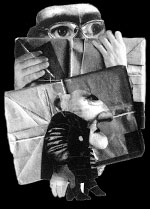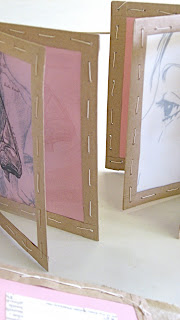Thursday, December 03, 2009
Wednesday, November 04, 2009
Exhibition opportunity!
Thanks!
Alicia Bailey
Abecedarian Gallery
www.abecedariangallery.com
910 Santa Fe, Unit #101
Denver, CO 80204
phone: 720.282.4052 or 303.340.2110
fax: 303.479.9556
Wednesday, October 28, 2009
Tarabeans Blog…form AND content
One of my favorite blogs ever is the CONVIVIO BOOKWORKS blog. I love these guys, the work they make (so unlike mine, but so attentive to details and so crisp and clean in its letterpress work.) I love the letters they send out every once in awhile….just talking about what they are doing and why – and telling stories about their lives and work. I have never met them, but they have answered every email I have ever sent them, quickly – and as if I am a long lost friend that they have just been waiting to hear from. This is from an email I saved – because I love the phrase in bold -
We also just got a fresh supply of Shaker Herbs in for the Convivio Book of Days Catalog… The house smells just like the Herb House at the Sabbathday Lake Shaker Community in Maine. Smell, great portal to memory.
This is a link to their latest project it…
http://www.conviviobookworks.com/pages/Works%20on%20Paper.html
This (in a very round about way) does bring me back to Tara’s blog and to Keith Smith.
Tara’s blog reflects her interests re: ideas and text. Even in her blog itself – there are not a lot of images …. and this is not a criticism …. because there are alot of ideas and thinking going on. She is honest – very honest. And she isn’t afraid to put herself out there and get messy with her thinking. I love this. It is where some hard work gets done and where some discoveries get made.
Text has played a major role in each of her projects this semester…the two she has finished as well as the one she is working on now. I have encouraged her to go back and read what Smith has to say about text – and I am going to share some of his thinking (and my own) here.
Smith outlines the ELEMENTS of the book….
the binding (the binding determines the type of book)
the pages
text and/or pictures
turning pages
display
He continues, “Like the formal elements within the single picture, the elements of the book function work in union to create the book. Each element must be conceived as part of and helps determine the other elements.
Picture, and/or text must be incorporated into the pages. If a writer hands material to a publisher, it is merely stuck into pages as convenient packaging.
Words should not be housed, but revealed by the (book) format.”
Let’s look at it another way as well….a book houses content…but in the genre of bookart – the book becomes the content as well. (not just the packaging).
Thomas McEvilley – in a riff on Wallace Steven’s 13 Ways of Looking at A Blackbird, wrote about 13 ways that we determine content in looking at art work. Very applicable to looking at our books – and in thinking about the elements of these final projects. The ( ) are my questions/comments to you.
1. Content that arises from the aspect of the artwork that is understood as representational. (DO we see nature based on how we have seen it represented in art?)
2. Content arising from verbal supplements supplied by the artist. (Title, what the artist says/writes)
3. Content arising from the genre or medium of the artwork. (How do we come to a painting vs. a book? How is a digital book different than a physical book – aside from the obvious?)
4. Content arising from the material of which the artwork is made. (When, for example, a jeweler works in some other medium than gold, because gold mining is damaging to the environment and does not return profits to the miners themselves.)
5. Content arising from the scale of the artwork. (Especially relevant for land art, earthworks. What about works at the nanoscale?)
6. Content arising from the temporal duration of the artwork. (Virtual work, Film, video, performance, music?)
7. Content arising from the context of the work. (Such as site specific work)
8. Content arising from the work’s relationship with art history. (A piece that specifically references something that came before it. Altered books in some cases – look at Smith’s examples of altered books made using Jansen’s History of Art.)
9. Content that accrues to the work as it progressively reveals its destiny through persisting in time. (Duchamp added content to the Mona Lisa – altered books, again)
10. Content arising from participation in a specific iconographic tradition. (Certain colors or forms, or even subjects, have a particular meaning (very similar to context)
11. Content arising directly from the formal properties of the work. (A Pollock drip painting asserts flux and indefiniteness of identity as qualities that can be found in the world.. Sherman photographs for a certain period formally reference 50′s film stills)
12. Content arising from attitudinal gestures (wit, irony, parody, and so on) that may appear as qualifiers of any of the categories already mentioned. (for eg., Natural Born Killers, which tells the story of a pair of mass murderers while parodying various media forms like TV sitcoms…)
13. Content rooted in biological or physiological responses, or in cognitive awareness of them. (Sexual arousal, disgust, visual responses like persistence of vision (when you stare at an image composed of complements and then look at a white wall and still see it, but with colors reversed) op art)
Friday, October 16, 2009
Thursday, October 01, 2009
Sarah Wilson – Series of 4 eightfolds in case
Calvin Whitehurst – Series of 4 eightfolds in case
Saturday, September 05, 2009
Creative Commons

What do you know about CC? You should be thinking about this as you put your own images out on the web…or utilize the images of others
Wednesday, September 02, 2009
circle press
...from their website...
CIRCLE PRESS, formed by Ron Kind in 1967, is both part of a tradition and a breaker of tradition. The stages of its life are marked not only by the individual natures of those whose books and prints it has published but also by the differing character of the decades through which it has passed. The Press has been highly productive for over forty years and has had a profound effect, directly and indirectly, on other artists working with books, for it has provided a continuity and a context against which such activity can be measured, even for those whose output and philosophy are utterly different or even opposed.....

Its genesis was King’s long fascination with Elias Canetti’s'Auto da Fe', the famously grotesque yet marvelous novel set in pre-war Vienna which contributed to Canetti winning the Nobel Prize for Literature in 1981. To accompany his illustrations, King commissioned Szirtes to write a text inspired by and related to Canetti’s great work.
In 2008 the book was published in a limited edition of 35 copies letter-pressed in Walbaum onto 240 lb Barcham Green mouldmade paper with 15 etchings, one double-spread, thirteen full-page and one half-page; a total of 18 unstitched sections 350 x 260 mm, enclosed in a uniquely collaged card wrap-around and placed in a cloth-bound solander box.
Sunday, August 30, 2009

Personas – try it out!
August 30, 2009 by lesliefedorchuk | Edit
Wednesday, August 26, 2009
RISORGIMENTO!!!
First step...get these blogs up and running. Would you like to check out what we are looking at, learning about, DOING???? Go to my netvibes site - and there you can find all the resources that we are using. Feel free to send us suggestions -- we are building as we go along.
This is the public component of our work. We will also be utilizing a course moodle for some of the work that we are doing.
I'm happy to answer any questions - always.









In making this book I struggled with paper weight and paper color. I am not a fan of yellowish looking papers which was the choice for the first book, so i chose a whiter paper. This paper was a heavier weight and in turn created some issues with the smaller books fitting in the case. The content in the book is somewhat mysterious and isn’t very literal but follows along with common numerology symbols that have been used for the numbers 1-4 over the centuries. I really did enjoy making the content for this book, it was probably my favorite part.